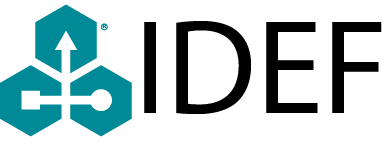
Overview
IDEF1 was designed as a method for both analysis and communication in the establishment of requirements. IDEF1 is generally used to 1) identify what information is currently managed in the organization, 2) determine which of the problems identified during the needs analysis are caused by lack of management of appropriate information, and 3) specify what information will be managed in the TO-BE implementation.
IDEF1 captures the information that exists about objects within the scope of an enterprise. The IDEF1 perspective of an information system includes not only the automated system components, but also non-automated objects such as people, filing cabinets, telephones, etc. IDEF1 was designed as a method for organizations to analyze and clearly state their information resource management needs and requirements. Rather than a database design method, IDEF1 is an analysis method used to identify the following:
- Information collected, stored, and managed by the enterprise.
- Rules governing the management of information.
- Logical relationships within the enterprise reflected in the information.
- Problems resulting from the lack of good information management.
The results of information analysis can be used by strategic and tactical planners within the enterprise to leverage their information assets to achieve competitive advantage. Their plans may include the design and implementation of automated systems which can more efficiently take advantage of the information available to the enterprise. IDEF1 models provide the basis for those design decisions, furnishing managers with the insight and knowledge required to establish good information management policy.
IDEF1 Principles
IDEF1 uses simple graphical conventions to express a powerful set of rules that help the modeler distinguish between 1) real-world objects, 2) physical or abstract associations maintained between real-world objects, 3) the information managed about a real-world object, and 4) the data structure used to represent that information for acquiring, applying, and managing that information. IDEF1 provides a set of rules and procedures for guiding the development of information models. One of the IDEF1 goals is to provide a structured and disciplined process for analyzing information managed by an organization. This goal is accomplished by the evolutionary process defined in the method and by the measurable results and specific products required by the method. IDEF1 enforces a modularity that eliminates the incompleteness, imprecision, inconsistencies, and inaccuracies found in the modeling process.
IDEF1 Concepts
There are two important realms for modelers to consider in determining information requirements. The first realm is the real world as perceived by people in an organization. It is comprised of the physical and conceptual objects (e.g., people, places, things, ideas, etc.), the properties of those objects, and the relations associated with those objects. The second realm is the information realm. It includes information images of those objects found in the real-world. An information image is not the real-world object, but the information collected, stored, and managed about real-world objects. IDEF1 is designed to assist in discovering, organizing, and documenting this information image, and thus is restricted to the information realm.
An IDEF1 entity represents the information maintained in a specific organization about physical or conceptual objects. An IDEF1 entity class refers to a collection of entities or the class of information kept about objects in the real-world. There are two basic concepts that distinguish entities:
- They are persistent. The organization expends resources to observe, encode, record, organize, and store the existence of individual entities.
- They can be individuated. They can be identified uniquely from other entities.
Entities have characteristic attributes associated with them. Attributes record values of properties of the real-world objects. The term attribute class refers to the set of attribute-value pairs formed by grouping the name of the attribute and the values of that attribute for individual entity class members (entities). A collection of one or more attribute classes which distinguishes one member of an entity class from another is called a key class. A relation in IDEF1 is an association between two individual information images. The existence of a relation is discovered or verified by noting that the attribute classes of one entity class contain the attribute classes of the key class of the referenced entity class member. A relation class can be thought of as the template for associations that exist between entity classes. An example of a relation in IDEF1 is the label "works for" on the link between the information entity called "Employee" and the information entity called "Department." If no information is kept about an association between two or more objects in the real-world, then, from an IDEF1 point of view, no relation exists. Relation classes are represented by links between the entity class boxes on an IDEF1 diagram. The diamonds on the end of the links and the half diamonds in the middle of the links encode additional information about the relation class (i.e., cardinality and dependency). The figure below illustrates the manner in which IDEF1 diagrams are drawn.

Figure 1: An IDEF1 Diagram
Strengths of IDEF1
IDEF1 is an effective method for documenting the informational requirements of an enterprise. The IDEF1 modeling exercise provides a foundation for database design, gives a definition of the information structure, and provides a requirements statement reflecting the basic information needs. IDEF1 uses a disciplined, structured technique to uncover the information and business rules used by an organization. This gives needed rigor to the method for untangling the complex challenge of modeling the information of the organization. IDEF1 requires the active participation of the information users. This serves to accurately model the organization by forcing the users to think about how and where the information is being used and managed. Finally, information models are useful throughout the life-cycle of the enterprise.
KBSI has developed an automated Information and Data Modeling tool, SMARTER®, to support the IDEF1 and IDEF1X methods.
